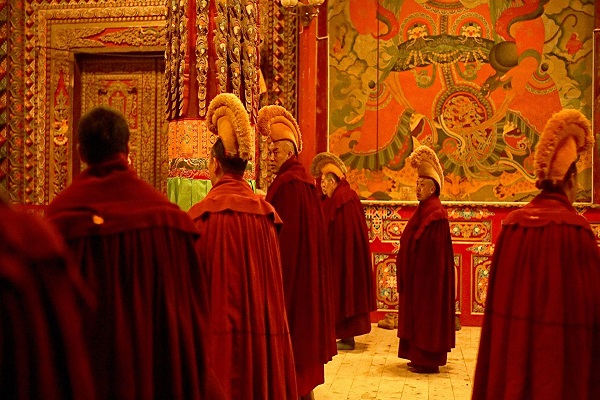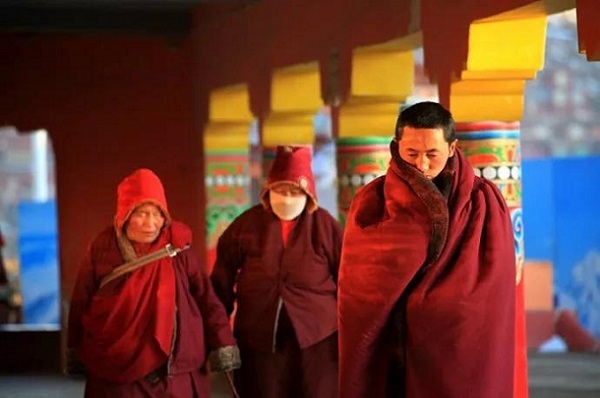Tibet’s landscape is dramatic — high plateaus, snow-capped peaks and centuries-old monasteries — but if you want a small, vivid symbol of Tibetan religious life, look at the head. The colorful, sculptural hats worn by Tibetan monks are not mere clothing: they are living emblems of lineage, rank, ritual and history. For international travelers who love culture, photography, and meaningful encounters, understanding the Tibetan monk hat opens a window onto how belief and identity are made visible here.
How Many Colors Are There for Tibetan Monk Hats?
Tibetan monk hats are shorthand for centuries of religious history. The simplest code to learn is color.
- Yellow hats are closely associated with the Gelug school (often called the “Yellow Hat” sect). Gelug monks wear yellow or saffron-colored headpieces in many formal contexts. The color signals a particular lineage, a strong emphasis on monastic discipline, and distinctive liturgical styles.
- Red hats usually identify Nyingma practitioners (the oldest of the Tibetan Buddhist lineages). Red here links to older tantric practices and traditions that predate some of the later reforms.
- White or lighter hats are sometimes used seasonally or by other schools; for example, certain Kagyu practices use white headgear in warmer months.
Color is not the only sign: hat shape, size and decoration also encode rank, academic achievement, and whether the hat is for daily wear or formal ceremony. As a traveler, spotting the color is the quickest way to begin a conversation with what you’re seeing.

Tibetan Monk Yellow Hats
Gelug – The Yellow Hat School: Discipline and Scholarship
The Gelug tradition rose to prominence through a reform movement emphasizing monastic discipline, scholastic study and a structured monastic system. The founder’s reforms reinforced rules about ordination, communal life and study — and the yellow hat came to symbolize these commitments.
For travelers this means:
- You are most likely to see yellow-hatted monks in major Gelug monasteries and in formal liturgies.
- The yellow color visually underscores Gelug’s public identity: structured, academic and ritualized.
When you visit Gelug monasteries, pay attention to processions and morning debates — occasions when hat colors and styles are especially visible.

Gelug Sect (Yellow Hat)
Nyingma – The Red Hat School: Ancient Lineage and Tantric Practice
Nyingma, literally “ancient,” is historically the oldest Buddhist school in Tibet. Its red hats are a visual reminder of lineage, tantric emphasis and practices that weave pre-Buddhist Tibetan religious elements into Buddhism’s tantric forms.
For travelers:
- Red hats often appear in ceremonial role and tantric ritual contexts.
- Nyingma’s aesthetic tends to be ornate and symbolic; some Nyingma headgear carries detailed color symbolism and layered meanings.
Seeing red-hatted masters at prayer or ritual can be one of the most photogenic and culturally dense experiences — but it also requires caution and respect.

Nyingma Sect (Red Hat)
Four Hat Families: Lotus, Pandit, Fan-shaped and Small
Tibetan monk hats are commonly grouped by silhouette. The four families below describe shape first, then cultural association and ceremonial use.
Lotus Hat
The Lotus Hat resembles a blooming lotus: rounded at the top with a lifted brim and an open front. Traditionally made from wool, often richly adorned, this hat is special.
- Who wears it? High-ranking lamas in certain lineages (especially within Nyingma). Some versions are reserved for legendary figures in the tradition, like Guru Padmasambhava—whose associated hat design is called the Pema Hat.
- Symbolism: Dual layers may stand for stages of tantric practice (development and completion); tripartite elements reference the three bodies of the Buddha; five-color motifs map to elemental or spiritual qualities.
- When worn: Major rituals, empowerment ceremonies, and when high lamas preside.
As a traveler, you will rarely see Lotus Hats in everyday monastery life; they appear at major ceremonies and special teachings.

Lotus Hat
Pandit Hat
The Pandit Hat (sometimes called the scholar’s hat) is perhaps the most recognizable and widely used hat across Tibetan Buddhist schools.
- Design: Pointed rounded top with long flaps that fall over the ears and shoulders.
- Variants: Banyen (longer flaps) and Bantong (shorter flaps). The length of the flaps can indicate different levels of scholastic attainment or mastery of particular knowledge traditions.
- Who wears it? Khenpo (scholars), Tripa (religious officers), senior teachers — and sometimes Gelug monks adapted this in yellow.
- Symbolism: The high peak represents middle-way teaching; long flaps symbolize the Two Truths doctrine (conventional and ultimate truth).
Pandit Hats are common in teaching halls, debates, and degree ceremonies. Expect to see them often in established monastic universities.

Pandit Hat
Fan-shaped Hat
Tall, wide, and dramatic — the Fan-shaped Hat commands attention. It often has pendants that drape to the shoulders, and its silhouette can look like a giant folding fan.
- Variants: Drozma (closely clustered crown tassel) and Zolu (more scattered tassels).
- Who wears it? In the great monasteries, general monks, deacons and ceremonial officials wear variants — with certain orders reserving Drozma for deacons or tantric practitioners.
- Symbolism: The fan shape can represent cosmological ideas (e.g., Western Pure Lands) and, with crown tassels, reference the thousand Buddhas.
Fan-shaped hats come alive during mass rituals; they add movement and color to chanting ceremonies and masked dances.

Fan-shaped Hat
Small Hat
Less ornate and more compact, the Small Hat carries quiet dignity. It was popularized within the Karma Kagyu lineage and used by successive Karmapas.
- Who wears it? Karma Kagyu masters, but also adapted by other masters across traditions.
- Variants: From a plain traditional small hat to a black, highly decorated ceremonial version.
Small Hats are often worn by chieftains of specific lineages or during certain rites that call for austere but symbolic headgear.

Small Hat
Tibetan Hats’ Symbolic Details: Colors, Feathers, Sun & Moon
Tibetan hats are rich in micro-symbols. When you learn to read those details, a hat becomes a story:
- Feathers or plumes might represent spiritual attainment or connection to specific myths.
- Sun and moon patterns often signal balance — wisdom and compassion, or the union of skillful means and insight.
- Five-color bands can correspond to the five Buddha-families or elements.
- Crests and tassels may signify vows, protection, or the multiplication of enlightened qualities.
These visual languages evolve across monasteries and lineages, so a detail in one monastery may carry a different local meaning elsewhere. That variability is part of the living tradition.
Where to See the Tibetan Monk Hats
If you’re planning a trip to Tibet primarily to see monastic life and its vivid costumes, here are the best contexts:
- Monastic universities and major monasteries: Drepung, Sera, Ganden, Tashilhunpo, and the monastic colleges around Lhasa are classic places to witness daily rituals, debates and formal teachings where hats appear regularly.
- Temple ceremonies: Morning prayers, pujas, and tantric empowerments frequently include formal headgear.
- Festivals: Large public festivals such as Losar (Tibetan New Year), the Shoton Festival (Yogurt Festival), and Monlam (Great Prayer Festival) bring out robes and hats in greater numbers, often accompanied by cham (masked dance) performances.
- Rural monasteries and nunneries: Smaller houses of practice maintain their own hat traditions; visiting them lets you see regional variety.
Timing matters. Many ceremonies happen early in the morning or on specific lunar calendar dates. If you want a guaranteed sighting, book visits to a monastery’s public prayer or festival calendar through a local guide or travel operator.

How to Watch Tibetan Monasteries Respectfully: Etiquette for Travelers
Tibetan monasteries are active religious spaces. Your curiosity is welcome, but it must be balanced with cultural sensitivity.
- Dress modestly: Cover shoulders and knees; avoid flashy clothing that distracts from ritual.
- Ask before photographing: Never assume photography is allowed — some rituals and individuals prohibit cameras.
- Keep a respectful distance: Don’t cross ritual thresholds, touch ritual objects, or stand where you will distract performers.
- Silence and small gestures: Whispered voices, slow footsteps and unobtrusive behavior are appreciated.
- Follow local guidance: Monastery attendants or translators will tell you where to stand or when to observe quietly.
If you’re uncertain, step back and watch what the local practitioners do. Mimic their behavior rather than imposing tourist norms.
The Story Behind Rank and Role: What Hats Tell Us About a Monk
Hats are not neutral; they often mark rank, scholarship and ceremonial responsibility.
- Senior lamas often wear heavily adorned Lotus Hats during empowerment ceremonies.
- Scholars and teachers wear Pandit Hats during lectures and degree conferrals.
- Deacons and ritual specialists may be identified by fan-shaped hats or variant forms during public liturgies.
- Lineage heads sometimes have unique small hats that mark their particular office.
Watching who wears which hat during a liturgy tells you who is leading, who’s teaching and who carries specific ritual authority — a live map of monastic organization.
Tibetan Monk Hats’ Regional and Seasonal Variations
Tibetan hat traditions are not identical across the Plateau. Local styles, material choices and color usage can shift by region:
- Highland communities may prefer heavier wool hats for warmth and durability.
- Lower-altitude monasteries sometimes adopt lighter materials or white variants for hot months.
- Historical centers like Lhasa retain older ceremonial forms, while newer diaspora communities adapt forms for travel and exile contexts.
This variety is one of the reasons visiting multiple monasteries—even within a single region—can be rewarding.
Common Misunderstandings of Tibetan Monk Hats
- Hats don’t equal politics. While some hat colors are associated with particular lineages that have historical political roles, the hats themselves are primarily religious markers.
- Not all monks wear hats all the time. Many hats are reserved for formal occasions; daily life can be much simpler.
- Color does not automatically mean rivalry. Different colors express doctrinal histories and ritual styles rather than simple opposition.
Understanding these nuances prevents reductive assumptions and deepens your appreciation of the living tradition.

Tibetan Monk Hats
Practical Travel Tips: Planning Your Hat-Spotting Trip
- Book a local guide: A local interpreter or monastery liaison will arrange visits and advise on what’s allowed.
- Time your trip around festivals: If your travel dates are flexible, plan around Losar, Shoton or Monlam for the richest visual displays.
- Check access rules: Some monasteries restrict foreign entry to certain areas; your guide will know.
- Pack for both weather and etiquette: Layered clothing for cold altitudes and modest attire for sacred sites.
- Be patient: Rituals run on their own rhythm; the most striking moments often come unexpectedly.
The Tibetan monk hat is a small object that carries enormous meaning. It is a bridge between the visible and the spiritual, a worn map of lineage, learning and ritual life. For travelers who approach it with curiosity and humility, it delivers more than a good photograph — it offers a glimpse into how a community expresses devotion, hierarchies and memory through form, color and movement.
If you’d like to plan a culturally respectful trip focused on monastic life, festivals and authentic encounters with traditional practices (including opportunities to safely observe and learn about Tibetan monk hats), China Dragon Travel specializes in tailored Tibet journeys for international travelers. We design itineraries that balance cultural immersion with responsible tourism — arranging local guides, respectful monastery visits, festival timing, and educational briefings so you can witness these traditions thoughtfully and meaningfully.












